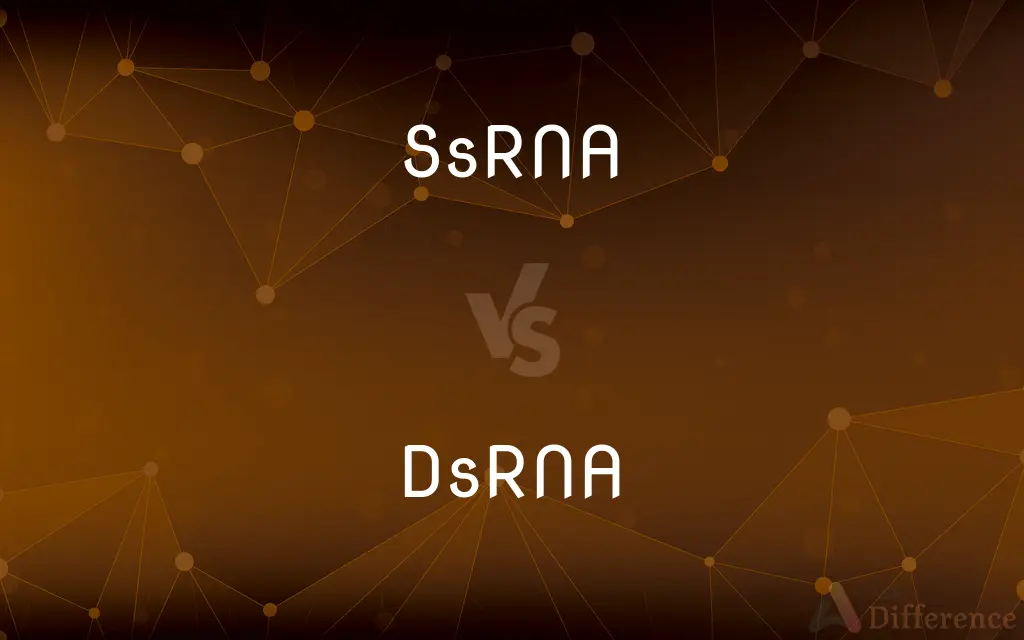SsRNA vs. DsRNA — What's the Difference?
By Tayyaba Rehman — Published on November 13, 2023
SsRNA is single-stranded ribonucleic acid, containing one linear sequence of RNA. DsRNA, double-stranded RNA, has two antiparallel RNA strands forming a double helix.

Difference Between SsRNA and DsRNA
Table of Contents
ADVERTISEMENT
Key Differences
SsRNA, or single-stranded RNA, is a type of ribonucleic acid consisting of a singular strand of RNA nucleotides. This characteristic singular structure allows it to serve various roles within cellular organisms, including being a messenger RNA (mRNA) that carries genetic information from DNA to the ribosome. Meanwhile, DsRNA, or double-stranded RNA, implicates a structure that contains two strands of RNA nucleotides, assembled in an antiparallel fashion, forming a double-helical structure.
DsRNA often emerges in cells as a byproduct of viral replication, thus commonly associated with viral infections. Viruses with DsRNA genomes utilize this type of RNA to encode their genetic information and reproduce within host cells. In contrast, SsRNA can serve numerous functions within cells, such as mRNA, transfer RNA (tRNA), or ribosomal RNA (rRNA), each of which plays crucial roles in protein synthesis and other cellular activities.
Notably, certain viruses have genomes comprising SsRNA, using its single-stranded nature to facilitate various reproductive strategies within host organisms. DsRNA viruses, in their turn, need to employ RNA-dependent RNA polymerase to replicate their genomes, owing to the host cells typically not containing enzymes capable of replicating DsRNA.
The distinction between SsRNA and DsRNA extends into the realm of cellular mechanisms and antiviral responses. While both SsRNA and DsRNA can be involved in various biological processes or disease mechanisms, their structural variations significantly influence their functional and mechanistic roles within biological entities.
Understanding the differences between SsRNA and DsRNA not only enables scientists to decode the multifaceted nature of RNA within organisms but also allows for enhanced exploration and understanding of the RNA viruses and the unique strategies they employ during infections. Furthermore, exploring their unique structures and functions helps in developing respective strategies for manipulating these RNAs for therapeutic or biotechnological applications.
ADVERTISEMENT
Comparison Chart
Structure
Single-stranded
Double-stranded
Viral Genomes
Includes some viral genomes
Includes different viral genomes
Cellular Roles
MRNA, tRNA, rRNA
Typically associated with viral RNA
Replication
Via various cellular roles
Requires RNA-dependent RNA polymerase
Antiviral Response
Detected by different PRRs
Often induces potent antiviral responses
Compare with Definitions
SsRNA
SsRNA consists of a single, unpaired RNA strand.
Many viruses, like the influenza virus, contain SsRNA genomes.
DsRNA
DsRNA is RNA with two complementary strands forming a helix.
DsRNA structures are often recognized by cellular antiviral mechanisms.
SsRNA
SsRNA structures can adopt various functional roles in cells.
SsRNA forms structures like tRNA, crucial for protein synthesis.
DsRNA
DsRNA can induce potent antiviral responses in cells.
The presence of DsRNA in cells triggers interferon responses.
SsRNA
SsRNA can act as a messenger, transferring genetic codes.
SsRNA, as mRNA, conveys genetic information from DNA to ribosomes.
DsRNA
DsRNA viruses replicate using specific RNA polymerases.
DsRNA viruses employ RNA-dependent RNA polymerases for their replication.
SsRNA
SsRNA viruses utilize their genome for infection and replication.
The SARS-CoV-2 virus uses its SsRNA genome to replicate within host cells.
DsRNA
DsRNA plays a role in RNA interference pathways.
DsRNA is processed into siRNA, mediating RNA interference in cells.
SsRNA
SsRNA is involved in gene regulation and expression.
Some SsRNA molecules regulate gene expression post-transcriptionally.
DsRNA
DsRNA often originates from RNA virus replication.
DsRNA intermediates form during the replication cycles of certain RNA viruses.
SsRNA
Alternative form of ssRNA
Common Curiosities
What does SsRNA stand for?
SsRNA stands for Single-stranded RNA.
How is DsRNA involved in antiviral defense?
DsRNA can trigger antiviral responses by inducing the production of interferons.
Can DsRNA be used for genetic manipulation?
Yes, DsRNA can be used in RNA interference, a technique for gene silencing.
What is the structure of DsRNA?
DsRNA has a double-helical structure formed by two antiparallel RNA strands.
Is SsRNA always involved in protein synthesis?
SsRNA can be involved in protein synthesis as mRNA but also takes other forms like tRNA and rRNA.
What roles does SsRNA play in cells?
SsRNA can function as mRNA, tRNA, or rRNA, playing diverse roles in cellular processes.
Can SsRNA form secondary structures?
Yes, SsRNA can form various secondary structures like hairpins and loops.
How does the cell recognize DsRNA?
Cells recognize DsRNA via pattern recognition receptors (PRRs) like TLR3.
What types of viruses have SsRNA genomes?
Various, including Flaviviruses and Coronaviruses, have SsRNA genomes.
Can SsRNA encode viral genomes?
Yes, some viruses utilize SsRNA as their genetic material.
How do SsRNA viruses replicate?
SsRNA viruses utilize various strategies, like reverse transcription or direct replication, based on their group classification.
Does DsRNA exist in non-viral entities?
DsRNA can exist transiently in cells but is commonly associated with viral entities.
Is DsRNA found in cellular processes?
Typically, DsRNA is not common in cellular processes but is related to viral replication.
Does DsRNA serve as the genome for certain viruses?
Yes, some viruses, like Reoviruses, have DsRNA genomes.
What is the relationship between SsRNA and translation?
SsRNA in the form of mRNA is translated by ribosomes into proteins.
Share Your Discovery

Previous Comparison
Inbound Logistics vs. Outbound Logistics
Next Comparison
Hotplate vs. Induction CookerAuthor Spotlight
Written by
Tayyaba RehmanTayyaba Rehman is a distinguished writer, currently serving as a primary contributor to askdifference.com. As a researcher in semantics and etymology, Tayyaba's passion for the complexity of languages and their distinctions has found a perfect home on the platform. Tayyaba delves into the intricacies of language, distinguishing between commonly confused words and phrases, thereby providing clarity for readers worldwide.
















































